
Münster is an independent city in North Rhine-Westphalia, Germany. It is in the northern part of the state and is considered to be the cultural centre of the Westphalia region. It is also a state district capital. Münster was the location of the Anabaptist rebellion during the Protestant Reformation and the site of the signing of the Treaty of Westphalia ending the Thirty Years' War in 1648. Today it is known as the bicycle capital of Germany.

Zell (Mosel) is a town in the Cochem-Zell district in Rhineland-Palatinate, Germany. Zell has roughly 4,300 inhabitants and is the seat of the like-named Verbandsgemeinde.
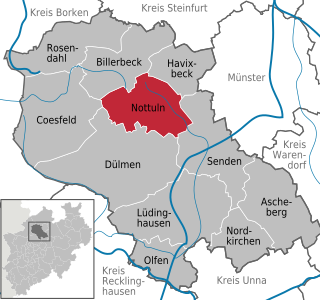
Nottuln is a municipality in the district of Coesfeld in the state of North Rhine-Westphalia, Germany.

Bad Münster am Stein-Ebernburg is a spa town of about 4,000 inhabitants in the Bad Kreuznach district in Rhineland-Palatinate, Germany. Since 1 July 2014, it is part of the town Bad Kreuznach. It was the seat of the former like-named Verbandsgemeinde, but not part of it. Bad Münster am Stein-Ebernburg was granted town rights on 29 April 1978 and is recognized as a mineral spring spa (Mineralheilbad) and a climatic spa. Today the "Spa" is famous for its clinics specializing in cardiological and orthopaedic rehabilitation. The many graduation towers form the largest open air inhalatorium in Europe.

Selm is a town in the district of Unna, in North Rhine-Westphalia, Germany. It is situated approximately 20 kilometers north of Dortmund and 25 kilometers west of Hamm.

The German Church, sometimes called St. Gertrude's Church, is a church in Gamla stan, the old town in central Stockholm, Sweden, belonging to the German Saint Gertrude Parish of the Church of Sweden.

The Holy Cross Church is a Catholic church in the Bornheim district of Frankfurt am Main (Germany). It is similar in design to the Frauenfriedenskirche in Frankfurt-Bockenheim. It was built by Martin Weber from 1928 to 1929, on a rise then known as Bornheimer Hang. The church is an unusual example of interwar modernism as sacred Bauhaus architecture.

St Michael's Church, Trelawnyd, is in the village of Trelawnyd, Flintshire, Wales. It is an active Anglican parish church in the benefice of Dyserth and Trelawnyd and Cwm, the deanery of St Asaph, the archdeaconry of St Asaph, and the diocese of St Asaph. The church is designated by Cadw as a Grade II* listed building.

Alois Johannes Plum is an artist working in Mainz, Germany, who has acquired a national reputation for his stained glass, his paintings, and his plastic art. Plum has been active since the 1950s and his work decorates hundreds of churches and public buildings in Germany. He has created many characteristic stained glass windows in churches renovated or rebuilt after the destruction of World War II, and is especially noted for his reinterpretation of historic sacred space and his integration of glass and architecture with careful attention to the liturgical function of his art.
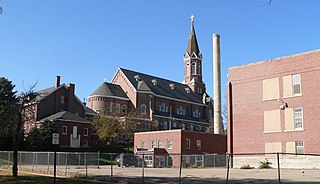
St. Boniface Catholic Church is a parish of the Diocese of Sioux City. The church is located in a residential area west of downtown Sioux City, Iowa, United States. The parish buildings form a nationally recognized historic district that was listed on the National Register of Historic Places in 1998 as St. Boniface Historic District. At the time of its nomination it contained three resources, all of them contributing buildings.

Münster Cathedral or St.-Paulus-Dom is the cathedral church of the Roman Catholic Diocese of Münster in Germany, and is dedicated to St Paul. It is counted among the most significant church buildings in Münster and, along with the City Hall, is one of the symbols of the city.

St. Martin is the name of a Catholic parish and church in Idstein, Rheingau-Taunus-Kreis, Germany. The official name of the church is Katholische Pfarrkirche St. Martin. The name of the parish became St. Martin Idsteiner Land on 1 January 2017, when it was merged with five other parishes. The parish is part of the Diocese of Limburg.

The Neustädter Kirche is a main Lutheran parish church in Hanover, Lower Saxony, Germany. The official name is Neustädter Hof- und Stadtkirche St. Johannis zu Hannover. The Baroque church was built in 1666–70. It is one of the oldest Protestant Saalkirchen in Lower Saxony, conceived for the sermon as the main act of the Lutheran church service. Mathematician and philosopher Gottfried Wilhelm Leibniz and Field Marshal Carl August von Alten are buried here.

The church St. Laurentii is the parish church of a Lutheran congregation in the centre of Itzehoe, Schleswig-Holstein, Germany. The full name is Stadtkirche St. Laurentii. Completed in 1718, it is the town's largest religious building. It serves as a parish church and as a concert venue.

St. Jakobus is a Catholic church and a former parish in Rüdesheim am Rhein, Hesse, Germany. It dates back to the 10th century, was expanded around 1400, and again in 1913/14. The church was severely damaged by bombing in World War II, and rebuilt from 1947 to 1956. It is a listed historic monument and serves also as a concert venue.
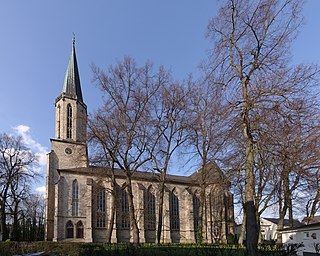
The Große Kirche Aplerbeck is a Protestant church in Aplerbeck, now part of Dortmund, Germany. It was built from 1867 to 1869 in Gothic Revival style, designed by Christian Heyden. A listed monument, it is used by the parish St. Georg, serving mostly as a concert church.
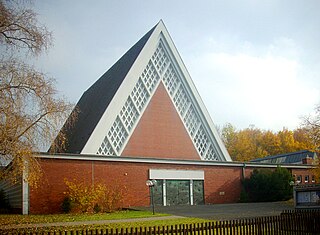
Zu den heiligen Engeln is a Catholic parish and church in Hanover-Kirchrode, Lower Saxony, Germany. The church was built in 1964 on a design by Josef Bieling, and was remodeled in 2014. It is now the parish church of a larger parish, serving the district Kirchrode-Bemerode-Wülferode. It belongs to the deanery of Hanover and the Diocese of Hildesheim. The church is dedicated to the angels.

A pilgrimage to a statue of Mary in Werl, North Rhine-Westphalia, Germany, caused the building of pilgrimage churches there. The first one, completed in 1662, was replaced by a Baroque building completed in 1789, which later became known as the Alte Wallfahrtskirche. When it became too small, an adjacent Wallfahrtsbasilika was built, dedicated to the Visitation. It was declared a Basilica minor in 1953.

St. Johannes Evangelist is a Catholic parish church in Cappenberg, now part of Selm, North Rhine-Westphalia, Germany. It was formerly the abbey church of Cappenberg Abbey built in Romanesque style. It is a listed monument as one of few extant large churches built before the mid-12th century in Westphalia.
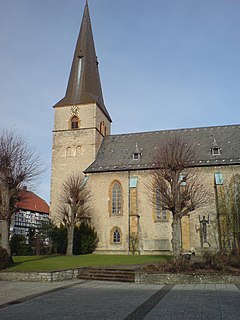
St. Jacobi is a Lutheran church and parish in Werther, North Rhine-Westphalia, Germany. The present building was begun in the 14th century, and was expanded in 1876. The parish became Lutheran in 1570.






















